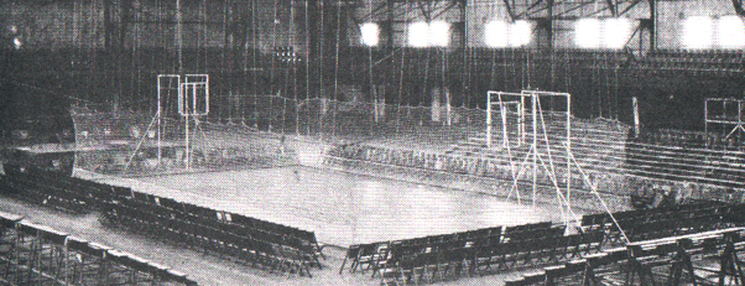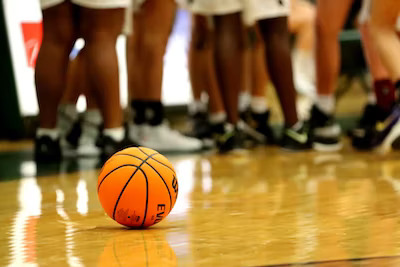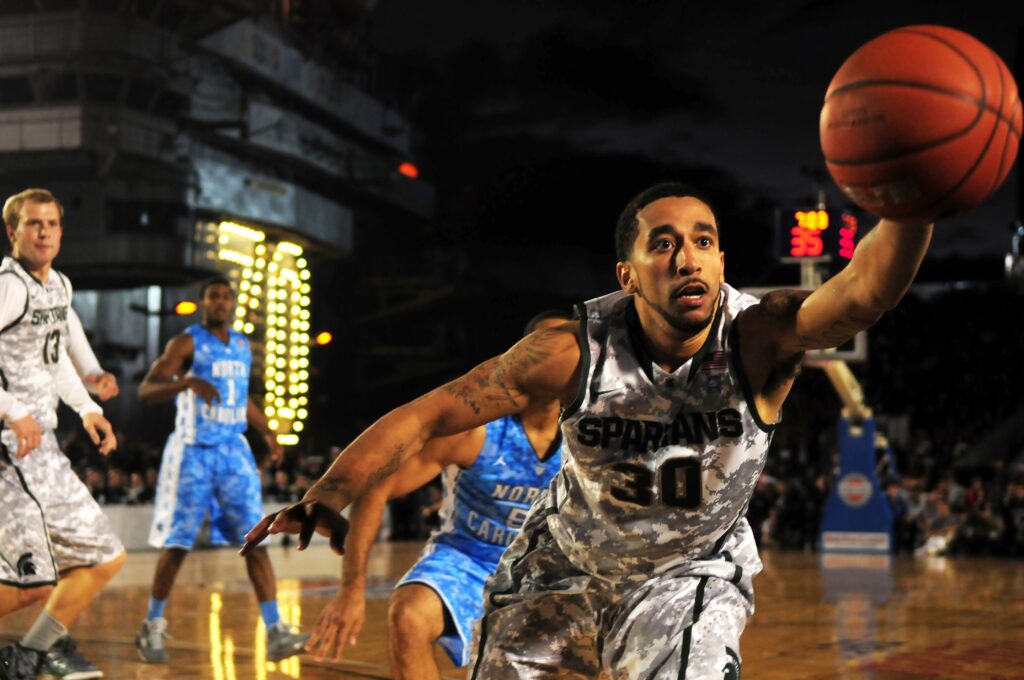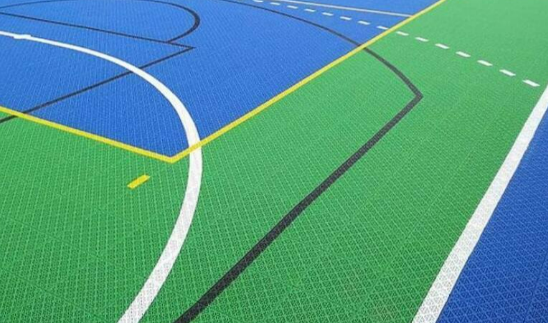Common Questions about Basketball
On an NBA team, there are typically 15 players, 12 of whom are allowed to be active for the game. International (FIBA) and WNBA rules state that teams must submit a 12-man roster to be eligible competitively. In college, there is no set requirement for players on a team, but in Division 1 basketball, each team has roughly 13 scholarships to allocate, and can also accept walk-ons.
However, it is important to note that, in regulation basketball games, a team can only have, at most, five (5) players on the court at any one time.
Men’s college basketball games at all levels consist of two (2) 20-minute halves, which in total adds up to a 40 minute game. This differs from the length of NBA games, which consist of four (4) 12-minute quarters (which adds up to a 48 minute game).
Women’s college basketball games consist of four (4) 10-minute quarters, which is the same length as a typical WNBA game.
In both men’s and women’s college basketball, overtime periods are five (5) minutes long.
The standard distance for the 3-point line in standard NCAA basketball is 20 feet, 9 inches in a continuous arc. This is the standard for both men’s and women’s college basketball. For perspective, the college 3-point line is a foot further away from the hoop than high school 3-point lines, and are anywhere from 1.25-3 feet further than the NBA 3-point line.
A college basketball rim, like the rim heights for all leagues consisting of players aged 12 and up, is 10 feet tall.
Men’s college basketball players, like their NBA and international men’s counterparts, use a Size 7 ball, which has a 29.5 inch circumference and weighs approximately 22 ounces.
Women’s college basketball players, like their WNBA and international women’s counterparts, use a Size 6 ball, which has a 28.5 inch circumference and weighs roughly 20 ounces.
A regulation high school 3-point line sits 19 feet, 9 inches away from the basket in a continuous arc.
This differs from the regulation college 3-point line, which rests 20 feet, 9 inches away from the basket, and the NBA 3-point line, which lies anywhere from 22 feet to 23 feet, 9 inches away from the basket, depending on the location on the court.
A high school basketball rim, like all regulation rim sizes for boys and girls aged 12 and over, is 10 feet tall.
High school basketball games typically consist of four (4) eight-minute (8) quarters, with a clock that ceases running at all whistled stoppages of play.
Because it varies from state to state, a typical high school overtime period lasts anywhere from two (2) minutes to four (4) minutes long.
A boy’s high school regulation basketball, like men’s college, men’s international, and NBA regulation basketballs, has a circumference of 29.5 inches and a weight of approximately 22 ounces.
A girl’s high school regulation basketball, like women’s college, women’s international, and WNBA regulation basketball, has a circumference of 28.5 inches and a weight of approximately 20 ounces.
An NBA basketball game is 48 minutes long. It consists of four (4) 12-minute quarters, with five-minute overtimes used if the score remains tied after regulation.
This differs from men’s college basketball games, which last 40-minute long and consist of two 20-minute halves.
NBA rims, like men’s and women’s high school and college basketball regulation rims, stand at 10 feet tall.
An NBA basketball, like regulation basketballs at the men’s high school and college levels (and at all levels of basketball above age 12), has a 29.5 inch circumference and weighs roughly 22 ounces.
WNBA basketballs are a slightly different size, with a 28.5 inch circumference and a weight of approximately 20 ounces.
The NBA 3-point line ranges from 22 feet (in the corners) to 23 feet, 9 inches (along the rest of the arc).
This differs from the WNBA and international men’s 3-point line, which stands at 21.65 feet in the corners and 22 feet, 1 ¾ inches along the rest of the arc.
The NBA 3-point line distance also differs from the regulation college basketball 3-point line (20 feet, 9 inches in a continuous arc) and the regulation high school 3-point line (19 feet, 9 inches in a continuous arc).
In basketball, a “pivot foot” is the phrase used to describe a player’s foot that must remain anchored to the ground as long as the player is stationary with the ball and is not dribbling. “Pivoting” is the act of rotating oneself around the anchored pivot foot.
For example, if Player A’s pivot foot is his left foot, he/she can rotate on the axis of the sole of his/her pivot foot and place his/her right foot wherever he/she pleases, as long as the pivot foot remains anchored.
If a player moves his/her pivot foot without dribbling first, changes his/her pivot foot, or drags the pivot foot, he has committed a traveling violation, and his/her team loses possession of the ball.
A traveling violation, also known as “walking,” occurs when a player in possession of the basketball switches his pivot foot, takes multiple steps without dribbling, jumps without releasing the ball midair, and picks his pivot foot up into the air and puts it back down without releasing the ball, among other instances.
A traveling violation results in the forfeiture of position for the offending player’s team.
Contrary to popular belief, the height of a dribble and the amount of steps taken while dribbling has nothing to do with traveling violations; those issues fall under double dribbles and carries.
In basketball, when a player is dribbling, he/she is propelling the ball downward to the floor with a single hand, either while stationary or during movement.
A double dribble (known officially as a discontinued dribble) occurs when a player who has ended his dribble (picked the ball up with two hands after already having dribbled) starts to dribble again.
A double dribble can also occur when a player dribbles the ball simultaneously with two hands, or touches it more than once before it rebounds off of the floor.
A double dribble, when called, results in a loss of possession for the offending player’s team.
Over time, the definition of a “carry” in basketball has been greatly relaxed.
The official definition of a “carry,” also known as a “palming violation,” is when a player allows the ball to come to rest in one hand or against his hip while dribbling the basketball, and then resumes his/her dribbling.
In the early days of basketball, carrying violations were called whenever a player placed his hand on the side of the ball.
Today, as witnessed Chicago Bulls coach Fred Hoiberg’s complaints regarding Boston Celtics’ point guard Isaiah Thomas’ handling of the basketball, the rules on carrying have been enforced in a far laxer manner.
The block-charge call, one of the most controversial and subjective calls for a referee to make, has been at the center of officiating disputes as long as the professional game has existed.
A charge occurs when a dribbler, or someone who has recently discontinued his/her dribble but still has momentum, runs into a defender who has established position on the court.
If the defender is moving, the correct call is a block. If the defender leans into the ball-handler, the correct call is a block.
But if the ball-handler is out of control and barrels into an established defender, the correct call is a charge.
Further complicating the matter is the institution of the restricted area, an area that encompasses the four feet in front of the basket in all directions, in professional, international, and college basketball.
If an offensive player makes ‘significant contact’ with a defender who is stationed in the restricted area, the correct call is a block.
Even if the contact would be a charge outside of the restricted area, if the contact occurs inside of the restricted area, the referee has no choice but to call a blocking violation.
At all levels of basketball, a backcourt violation occurs when the ball has been advanced past midcourt, with the team then in possession, without any oppositional interference (I.E. deflection, loss of possession), returning to the backcourt while maintaining possession of the ball.
This is also known as an over-and-back violation.
The dimensions of an NBA court are 94 feet by 50 feet.
This differs from high school basketball courts, which has a typical length of 84 feet while maintaining the width of 50 feet.
Under international rules, court dimensions are slightly different, at 91.86 feet by 49.21 feet.
An offensive 3-second violation occurs when an offensive player remains with both feet inside the key (the painted area with the foul line at the top) while their team has retained possession of the ball. If an offensive player maintains one foot outside of the key, he cannot be legally called for a 3-second violation.
A defensive 3-second violation occurs when a defensive player remains inside of the key for longer than 3-seconds, but is further than an arms length from his matchup and is not actively guarding any offensive player.
The defensive 3-second rule, intended to discourage camping out in the paint zone defenses, is not used in collegiate or international basketball, but is used in WNBA play.
The penalty for an offensive 3-second violation is loss of possession.
The penalty for a defensive 3-second violation is a technical foul called on the offending team.




